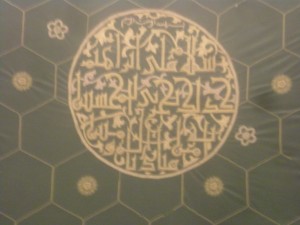
Been a busy week for me, so I apologize for the delay on this Mystery Photo, but I hope that won’t ruin the momentum I’ve been building with these: more comments/guesses each week. Keep ’em coming gang! I love seeing your guesses on these!
I liked the responses to last week’s photo. A nice mix of correct answers, and almost correct answers. The picture was in fact from the baptistry of the Northern Church (more on that later) from the ancient Nabatean city of Avdat. Ilana was the first with the correct answer, and Aaron and Steven both got it right as well, with Steven giving the most complete and detailed answer. (By the way, for those who read Steven’s comment, stay tuned for a review post soon on the excellent materials from Biblical Backgrounds, his company.)
Many of the incorrect answers from last week focused on other Nabatean cities in the Negev, namely Mamshit and Shivta. So let’s discuss the Nabateans and the Negev a bit.
When most people think of the Nabateans, they think of Petra, their amazing capital city in today’s Jordan. And while, no doubt, not nearly as impressive as those at Petra, we have a lot of interesting Nabatean remains here in Israel as well. There are the remains of six cities and a number of other sites that relate to the Nabateans in Israel’s Southern Negev desert.
I intend to do another “What Is…?” post on the Nabateans, so I will just write briefly about them here. The Nabateans were a group of desert nomads whose main business in the early days was spice trading in the ancient world. Because of their unique knowledge and abilities regarding water in the desert, they were able to travel long distances there while no one else dared to do so. Thus they were able to bring spices from the southern Arabian peninsula to the Mediterranean coast, naturally bringing them through Israel’s Negev. (I wrote a bit about the Nabateans and their connection to water in the desert in this post on an environmental tour I gave in the Negev.)
The nation probably began to grow and engage in this kind of business as early as the fourth or third century BCE. Over time, however, their lifestyle changed. They became less and less nomadic, and began to build settlements that eventually grew into cities. As economic realities changed, they also changed their businesses, engaging in such things as agriculture and wine production. When different cultures took over rule of their territory, they assimilated culturally, changing their names and religious beliefs over time. First they worshiped hybrid gods — those with names that combined those of prior Nabatean gods and Roman gods. Later, they became religious Christians.
This explains why there are in fact many churches in the Negev’s Nabatean cities. The remains we find are primarily from the Byzantine era, and the Nabateans there were primarily observant Christians. In Avdat, there are remains of at least 3 or 4 different churches! This is why Steven specified it was from the Northern Church, which is correct, though the name is confusing to me. I’d rather refer to it as the Western Church, because it is the western-most church in the city, while there are other churches that are equally north. Still, that is how it is typically called, so I must stick with the accepted terminology.
Yossi correctly identified the item we were looking at as a cruciform baptismal font, and Norah wisely picked up on the fact that it had to be an early Byzantine one do to the equal length legs of the cross, rather than the elongated vertical line. (And of course, Norah’s young daughter Senai is completely correct that the picture is of a ruin!)
What happened to the Nabatean people later is unclear. But it is assumed that they left during the 8th Century CE, in the middle of the Muslim Period here, and simply assimilated into the surrounding culture wherever they went.
In some ways (though certainly not every), I see today’s Bedouins as having parallels to the Nabateans. They are a nomadic people that is in the process of transforming into a more sedentary culture. Similarly, they are in the process of adapting their livelihoods to the new surrounding culture. This is why we see many of them in such fields as hospitality or restaurants. I do not know of them specifically assimilating religiously, but I still feel there are some interesting parallels here.
Anyway, congrats to the correct respondents last week! This week’s photo may be challenging, but I think that it should present us with an interesting post next week. And I suppose that anyone who reads Arabic may have an easier time with this one! But as always, bring the guesses on!

Mofo I had that and changed it under the advice of my freind!
Thats reason 782934.1 why u dont listen to women
You had Avdat before and changed it to Masada?! That’s funny!
That would be the covering on the monument in the Avraham Avinu hall of the Maarat HaMachpela in Hevron
You’ve got me again! I don’t know what it is but here are my observations. It appears to be part of a tapestry of the type that covers grave markers.
It looks like the writing is Arabic so I would assume that it is at the grave of someone who is holy to the Muslims or Druze.